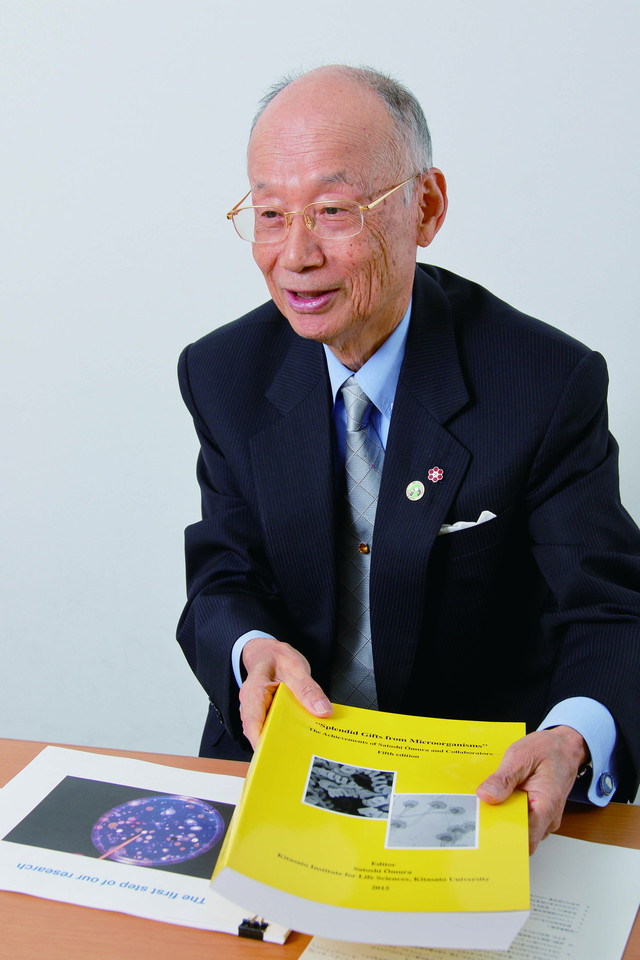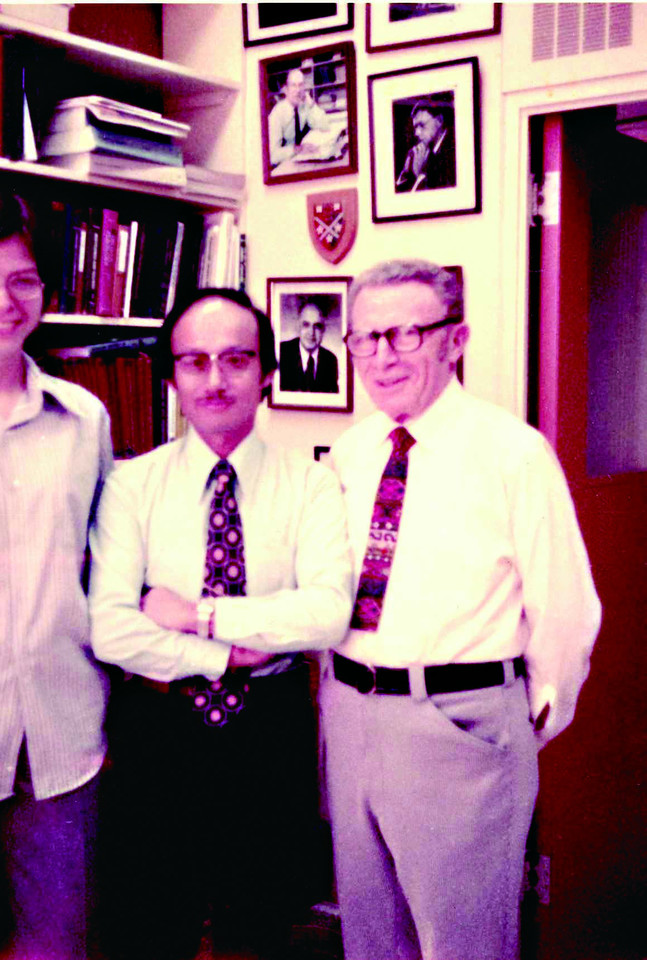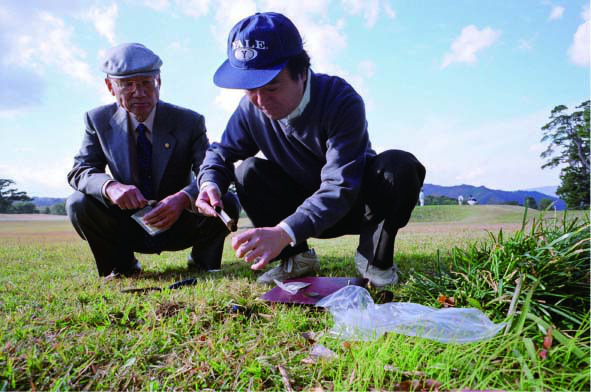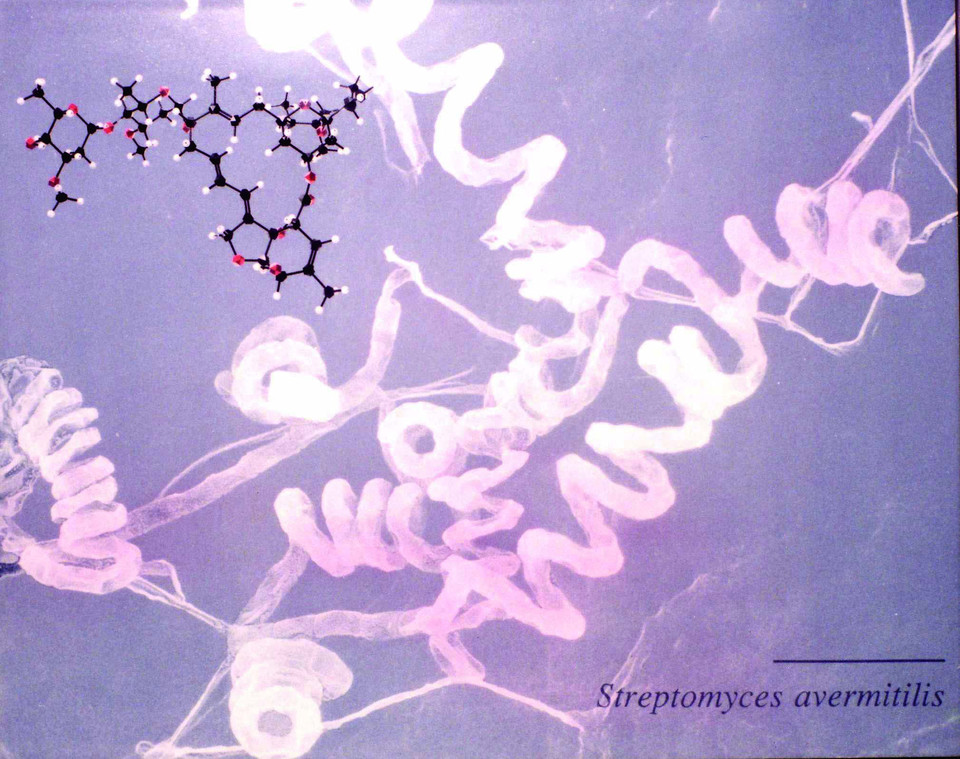Satoshi Omura
Born in 1935. Graduated from the University of Yamanashi, where he majored in natural science. Received a doctorate in pharmaceutical sciences from the University of Tokyo in 1968 and a further doctorate in chemistry from the Tokyo University of Science in 1970. Worked as a professor at the School of Pharmacy at Kitasato University and served as president of the Kitasato Institute. Currently distinguished professor emeritus at Kitasato University.
Professor Omura holds the “Yellow Book,” a comprehensive compendium of the products and results of his research team.
“I did half the work for the Nobel Prize, but the credit for the other half goes to the microbes,” says Professor Satoshi Omura with a smile on his face. Omura, distinguished professor emeritus at Kitasato University, was selected as one of the recipients of the 2015 Nobel Prize in Physiology or Medicine for his contributions to the development of a novel therapy against parasitic infections using a substance produced by a single microorganism he discovered.
In 1974, during the course of his ongoing collection of soil samples for microbe research, Professor Omura discovered a new kind of bacterium in soil from Shizuoka Prefecture. This finding effectively changed his life. Joint research with the U.S. pharmaceutical company Merck & Co. led to the discovery of avermectin, an anti-parasitic compound produced by this bacterium, and development of the derivative drug ivermectin.
From 1981, ivermectin quickly became the world’s most widely used anti-parasitic drug for livestock and domestic animals. And since 1987 it has been used in a program orchestrated by the World Health Organization to eradicate the devastating tropical diseases of river blindness and elephantiasis. Merck and the Kitasato Institute have supplied the drug, formulated for human use under the brand name Mectizan®, free of charge, currently providing it to around 300 million people every year. Mectizan® has already virtually eliminated river blindness in Latin America and is proving highly effective in Africa. It is projected that both targeted diseases will be eliminated globally within the next decade.
Professor Omura enthuses about the boundless potential of microorganisms: “Microbes came into existence three billion years ago, while humans have only been around for two hundred thousand years or so. We’re still just tapping a few percent of their potential, simply because we don’t know how to use them.” After graduating from the University of Yamanashi, he immersed himself in experiments in organic chemistry at the Graduate School of the Tokyo University of Science while working as a teacher at a Tokyo metropolitan high school. He first became interested in microbes after taking a job as a research assistant in the Fermentative Production Department of the Faculty of Engineering at the University of Yamanashi. Then he joined the Kitasato Institute, founded by Shibasaburo Kitasato, the father of bacteriology in Japan, with the aim of undertaking microbial research in earnest.
Visiting an elementary school in Ghana in 2004. All of the children regularly take Mectizan®, which they know by name.
In the course of his education and career, Professor Omura had a number of highly fortunate encounters with extraordinary scientists. Among his many mentors, the most important was Professor Max Tishler of Wesleyan University in Connecticut, who arranged for him to serve as a visiting professor in 1971. There he was involved in implementing an approach that had not yet been adopted in Japan’s scientific research circles, namely, to conduct research in cooperation with business. He had always declared his desire to conduct research that would help people, and after returning to Japan he applied the approach he learned in the United States for this purpose, becoming a pioneer in the development of industry-university tie-ups in Japan.
Professor Omura’s socially minded posture as a researcher has extended into other parts of his life as well. He drew on the tremendous royalties he received from sales of ivermectin and other products to provide large-scale funding for research at the Kitasato Institute while serving as its vice-president. And he has remembered his hometown of Nirasaki in Yamanashi Prefecture, using his own money to develop a hot spring for local residents and to build an art museum that he has donated to the city.
So far, Professor Omura’s research team has discovered almost 500 compounds produced by microbes that have led to the development of pharmaceuticals and other useful chemicals. Believing that microorganisms may hold the key to defeating diseases that remain intractable, he continues to work today on projects for creating drugs from naturally produced substances. “These projects increasingly require the power of youth,” Professor Omura says, and he devotes himself to training young researchers at the Kitasato Institute and Kitasato University. He is looking ahead avidly to exploiting the unlimited possibilities that future research on microbes will create for the benefit of all.



































































































































